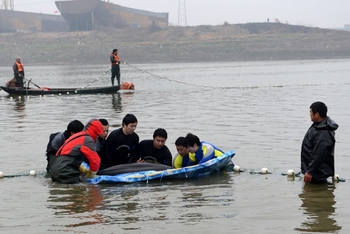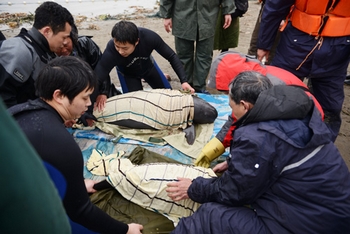
Newsroom
Rescuing Four Trapped Yangtze Finless Porpoises in Wuhan

Four trapped Yangtze finless porpoises were rescued in a side channel of the Yangtze River nearby Wuhan, Hubei Province. (Image/IHB)
Four trapped Yangtze finless porpoises were rescued in a side channel of the Yangtze River nearby Wuhan, Hubei Province. These rescued porpoises were translocated to the Tian'e Zhou Oxbow which is the only off-site conservation reserve for finless porpoises both in China and the world. The following two weeks' monitor survey conducted in the oxbow revealed that these four porpoises have been successfully rescued.
This relief operation was led by the Ministry of Agriculture. Researchers from Institute of Hydrobiology (IHB), Chinese Academy of Science, along with the staff from the Office of Aquatic Fauna and Flora Conservation (Ministry of Agriculture), Hubei Bureau of Aquatic Products, Wuhan Bureau of Agriculture and 21 experienced fishermen participated in this operation. Four dolphin trainers from the Wuhan Polar Ocean World and the East Lake Sea World also joined to help the rescue.
On 14th Dec 2013, four Yangtze finless porpoises were reported to be trapped in a narrow side channel nearby Wuhan. The width of the channel is only approximately 400m and the length is 3,000m with an average depth of 4m. In this operation, one calf was observed among this group. Judging from the body shape and swimming style, the calf was born in 2013 and maybe was still nursing, so it would be dangerous to catch it from water immediately. All the human activities around the water were banned during this period. Researcehrs took one month to observe the animals before rescued them.
 |
| These rescued porpoises were translocated to the Tian’e Zhou oxbow, which is the only off-site conservation reserve for finless porpoises both in China and the world.(Image/IHB) |
This is the first time that the successful rescue of trapped yangtze finless porpoises has been achieved in the main stem of the Yangtze River. Translocate the rescued porpoises to the off-side reserve could be a very important step for the conservation of Yangtze finless porpoise. Firstly, moving the rescued porpoises to the Tian'e Zhou reserve could improve the genetic structure of the population in the oxbow effectively and enhance the level of genetic diversity. Secondly, these rescued porpoises could exchange with the other four porpoises living in the oxbow, the latter of which would be the fundamental population of the to-be-established off-side reserve in He Wang Miao oxbow. Thirdly, this event has aroused great public attention to the issues regarding the protection of the Yangtze finless porpoise.